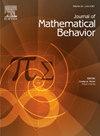Discursive tuning: The case of digital environments
IF 1.7
Q3 EDUCATION & EDUCATIONAL RESEARCH
引用次数: 0
Abstract
This paper introduces discursive tuning as a new commognitive notion for analyzing how students engage with a digital environment and react to unexpected responses they receive from it. Discursive tuning provides a theoretical tool for describing changes in students’ discourse in response to commognitive conflicts arising during their activity with the digital environment. We discuss the notion’s analytical capacity through some episodes from a study in which upper secondary students interact with the dynagraph of the function f(x)= 1/x. Our analysis identifies specific cases of discursive tuning that occur when students attempt to include into their discourse narratives that are consistent with the behavior of the dynagraph or with canonical mathematical discourse. These cases illustrate how discursive tuning provides insight into how students can resolve commognitive conflicts in productive ways.
话语调优:数字环境的情况
本文介绍了语篇调整作为一种新的交际概念,用于分析学生如何参与数字环境并对他们从中收到的意外反应做出反应。语篇调音提供了一个理论工具来描述学生在与数字环境的活动中产生的交际冲突所导致的语篇变化。我们通过一项研究中的一些片段来讨论这个概念的分析能力,在这项研究中,高中生与函数f(x)= 1/x的动态图相互作用。我们的分析确定了当学生试图在他们的话语叙述中包含与谱图行为或规范数学话语一致的话语时,就会发生话语调整的具体情况。这些案例说明了语篇调优如何帮助学生以富有成效的方式解决交际冲突。
本文章由计算机程序翻译,如有差异,请以英文原文为准。
求助全文
约1分钟内获得全文
求助全文
来源期刊

Journal of Mathematical Behavior
EDUCATION & EDUCATIONAL RESEARCH-
CiteScore
2.70
自引率
17.60%
发文量
69
期刊介绍:
The Journal of Mathematical Behavior solicits original research on the learning and teaching of mathematics. We are interested especially in basic research, research that aims to clarify, in detail and depth, how mathematical ideas develop in learners. Over three decades, our experience confirms a founding premise of this journal: that mathematical thinking, hence mathematics learning as a social enterprise, is special. It is special because mathematics is special, both logically and psychologically. Logically, through the way that mathematical ideas and methods have been built, refined and organized for centuries across a range of cultures; and psychologically, through the variety of ways people today, in many walks of life, make sense of mathematics, develop it, make it their own.
 求助内容:
求助内容: 应助结果提醒方式:
应助结果提醒方式:


